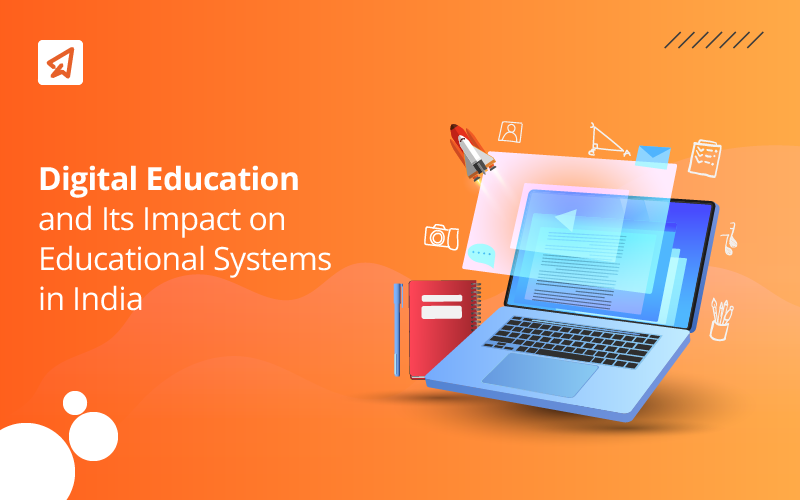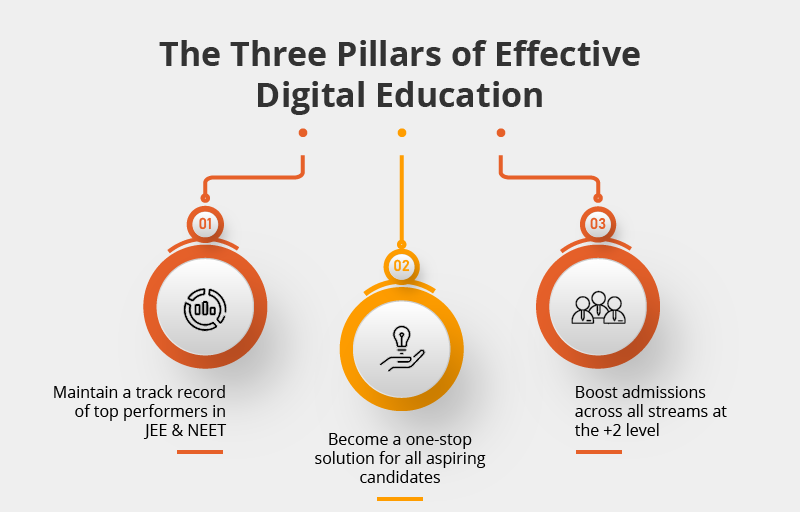Digital Education and Its Impact on Educational Systems in India

The rapid spread of technology and internet connectivity has enabled digital transformation in education. Slowly but steadily, the use of technology in education has grown from being an inconsequential tool to being the greatest enabler for enhancing educational experiences. It offers more efficient and accurate ways to accomplish educational goals and reduces costs for educational institutions. Due to the digital transformation in education, schools can offer high-quality learning experiences, bridge geographical gaps, and better prepare their learners for real-life challenges.
Visionary educators deem digital technology to be the most significant revolution in learning and teaching. In a country like India, with millions of learners – digital technology can enable us to offer greater access to education, better learning experiences, and a learner-centric educational approach. In future, digital education will be an integral part of our education system – and personalised learning will be the epitome of educational success. This article elaborates on the benefits of digital education in India and the challenges it can help us solve.
What is Digital Education?
Digital education involves using digital technologies to facilitate instruction and learning in educational institutions. In digital education, schools employ digital devices, software applications, and interactive content to improve the learning outcomes for their students. The objective is to offer learners various educational resources and interactive content that enables them to learn as they prefer. Smart classrooms, tablet-based digital libraries, learning tablets, and mobile applications are all good examples of tools for digital education. In essence, digital education meaning lies in leveraging technology to enhance the teaching and learning experience, making it more accessible, engaging, and effective for students.
The Three Pillars of Effective Digital Education

Experts define these three aspects of learning as the primary building blocks of digital education:
- Content – In traditional education, access to the proper curriculum content was a significant obstacle for thousands of learners – especially those who lived in remote areas. Digital education ensures that all learners have access to high-quality, curriculum-aligned content, leveraging digital technology in education. Most governing education bodies try to make educational content free, open, and accessible through digital technology.
- Capacity – If digital education must succeed, teachers and learners need digital literacy. Therefore, the next pillar of digital education is to create awareness and literacy about using digital resources among teachers and students. Educators should know how to access and leverage the latest tools in digital education to support their learners.
- Connectivity – Connectivity to the internet is vital for digital education. Without the internet, it is impossible for students to get access to digital education resources or to leverage new-age learning experiences.
Extramarks - Revolutionising Digital Education in K-12 Classrooms
Upgrade your classrooms. Enhance learning for your students.
Talk to Our ExpertAdvantages of Digital Education
- Personalised Learning – A pertinent benefit of digital education is personalised learning. Adaptable digital resources allow learners to learn according to their own pace, preference, and learning style. Students can focus more on challenging areas without peer pressure, leading to better comprehension and retention.
- Flexible Access to Learning Resources – In digital education, learners can access learning resources anytime and anywhere. Students now have high-quality academic resources at their fingertips. Digital education also involves interacting with other students worldwide to learn from each other and discuss interesting topics with like-minded learners. It allows learners to study the subjects they are interested in, at the pace they prefer, using the mode of instruction that is easiest for them. These benefits of digital education are especially useful for those who study while working and allow them to continue their education as they earn.
- Interactive & Engaging Learning – Interactive lessons, animations, MCQ-based practice, and multimedia learning aids make it easier for learners to grasp new concepts and strengthen their understanding. Digital education uses engaging and interactive learning aids that motivate students to participate in the learning process. Besides, connectivity to other learners enables them to collaborate and work in teams, leading to holistic development.
- Data-Driven Insights – Teachers and educators can assimilate and analyse valuable teaching and learning data about their students. It can help them find the areas of improvement and develop targeted instruction approaches to overcome them. Analysing individual and class performance data can help teachers bridge learning gaps and enable learners to focus on their strong areas.
- Holistic Learning with New Digital Education Strategies – Fresh learning strategies such as gamification, micro-learning, and interactive digital aids are gaining immense popularity in classrooms worldwide, showcasing the impact of digital technology on education. Providing a wide array of learning resources caters to the diverse learning styles of individual learners and enables them to develop a well-rounded comprehension of subjects. New digital education strategies teach students to adopt and use new technology while learning new skills.
- Building Community & Improved Communication – The connectivity in smart classrooms helps students and teachers build better relationships. Everyone can ask questions, raise concerns, and work together for holistic education. Better communication channels also foster creativity, critical thinking, and collaboration among learners of all ages.
- Enhanced Learning Outcomes – Digital education establishes systems wherein students are accountable for their learning, and they can control the subject and style of learning, within the digital education system. Educators can also track students’ progress using various analytical tools that give them a better insight into their learning needs.
How Digital Education Can Solve the Biggest Challenges of Indian Education?
The Indian education has grown from a humble 64.9% literacy rate to 74.37% in the past two decades. And yet, there are several challenges that our education system needs to overcome to fulfil our country’s learning needs. Recognizing the importance of digital education, can potentially improve access, quality, equity and relevance to address various problems in our schooling system. Therefore, more educators are adopting digital aids to support their educational endeavours.
Challenge 1 – Bridging the Digital Divide
The digital divide is the gap between those with access to the internet and those without access. According to the 2020 report by IAMAI and Neilsen, only 45% of India’s population has internet access. {SOURCE} That excludes a significant section of the population from the benefits of connectivity and education.
Solution – Digital Libraries
Schools can now create digital libraries with all the relevant learning content. Students can access these libraries using school-owned tablet computers. It can help establish a vast, content-rich, and easy-to-access library for schools at a fraction of the cost of a traditional library.
Now, you can seamlessly integrate state-of-the-art digital infrastructure to enhance the classroom learning environment and make the instruction process more learner-centric. Extramarks partners with schools and colleges to establish a smooth-functioning and reliable digital education infrastructure with our robust and well-trained classroom support.
Challenge 2 – Reluctance Within the Education Fraternity
The education fraternity consists of students, parents, government, educators, and administrators in the education ecosystem. All sections of this fraternity exhibit some degree of inertia at the prospect of adopting technological solutions to traditional education, including digital education in schools. Using a digital tool requires changes in existing systems, training, and extra efforts. Such reluctance from the education fraternity may deter school leaders from implementing digital solutions in their schools.
Solution – User-friendly Educational Platforms
As digital education evolves, new-age online learning tools are simple to use, easy to integrate in traditional education, and engaging for learners. It enables educators to switch from traditional practices to digital education with little effort. Learners also welcome digital aids as they are interactive and engaging, allowing them to learn at their own pace.
Extramarks School Solutions are designed to streamline and automate administrative tasks, support teachers in their pedagogy and build a memorable learning experience for learners. With features like learning analytics, holistic assessments, and two-way communication, Extramarks’ innovative school solutions foster a collaborative educational journey for all stakeholders.
Challenge 3 – Low Enrolment Rate, High Drop Outs, & Low Attendance
Indian government schools have low enrolment and attendance rates, especially at the high school level. According to the UDISE 2021-22 survey, Indian government schools had an enrolment rate of 72.8% {SOURCE}. They also witness high dropouts at all levels.
Solution – Immersive and Engaging Learning Content
Using digital education tools can create a more enriching and engaging learning experience for learners at all levels. Students look forward to interacting with digital learning aids and learn better when they are more engaged and immersed in the learning process.
Extramarks smart class solutions help teachers engage students in the lesson and enjoy the learning experience. Schools that partner with Extramarks experience high enrolment, better attendance and reduced dropout.
Challenge 4 – Historical Learning Gap
India aims to promote inclusivity in education and enable all Indian learners to gain access to high-quality learning opportunities for everyone. However, a historical learning gap has left thousands of students with many years of learning gaps in India. The traditional Indian learning ecosystem cannot cater to the varying needs of students with learning gaps.
Solution – Personalised Learning Solutions
Learning applications with artificial intelligence adapt to a student’s learning needs and level of understanding to create a personalised learning experience. Learning at their own pace empowers learners to overcome learning gaps and catch up with other learners their age.
Extramarks offers personalised adaptive learning solutions through its smart class application. It enables learners to choose their pace and level of study. Our proven learning pedagogy follows the diagnose, learn, practise, test, and evaluate process to create a holistic learning experience for diverse learners.
Challenge 5 – Gender Disparity
Gender disparity is a social issue that exists in all spheres of Indian society. Education is not an exception to this challenge. The Indian education system must overcome the legacy effect of generations of gender inequality to bring female students at par with male students.
Solution – Partnering with Private Educational Institutions for Empowering the Girl Child
Government and NGOs working to uplift women and girl-children at the grassroots level should partner with digital educational institutions to enable girls to pursue their education despite unfavourable circumstances. Online learning solutions can empower girls with the knowledge and awareness they need to improve their social status.
Extramarks Learning App can be used by any student with a phone and an internet connection. Girls living in remote areas of our country can access high-quality learning resources on our application.
Challenge 6 – Measuring Progress & Learning Outcomes
The Indian education system has initiated various programs and schemes for improving education for the untouched pockets of Indian learners. However, measuring the progress of the learners studying under such initiatives and analysing the learning outcomes of the government’s initiatives is a challenge.
Solution – Digital Monitoring & Reporting Data
Digital learning can measure and analyse the learners’ and teachers’ interaction with the application anytime and anywhere. It can help the government and schools find vital information about education initiatives’ engagement and learning outcomes.
Extramarks Smart Class Pus Program enables educators to gather valuable insights about their learners and their application usage. We enable educators to design hassle-free assessments for unlimited classroom practice – even if your students prefer paper and pen exams; you can instantly grade the papers and gather data about the learning outcomes in real time.
Challenge 7 – Apprehension About the Cheating Prevention Abilities of E-learning Platforms
Educators who have never worked with online examination platforms doubt their ability to prevent cheating. Students who are adept with technology may easily find a way to cheat the system to achieve a better evaluation grade.
Solution – Establishing Credibility by Using High-End Technology
Advanced technologies like AI and ML, facial recognition, remote proctoring, and intelligent timer solutions can help prevent malpractices. Educational institutions should assess the technology offered by different edtech providers and only partner with those who offer credible solutions.
Extramarks schooling solutions create unique yet similar questions for each student to make cheating impossible during an examination. Educators can create unique learning and testing experiences for each student using unlimited variations of the same questions with our Power Questions feature.
Pedagogical Approaches, Curriculum Development, Assessments & Technologies Used in Digital Education
Pedagogical Approaches to Digital Education
Digital education promotes innovative pedagogical approaches that transcend traditional classroom boundaries. These methods include –
- Blended Learning: Combines traditional face-to-face teaching with online instruction, allowing for flexibility and self-paced learning.
- Gamification: Incorporates game design elements in educational contexts to motivate and engage students.
- Project-Based Learning (PBL): Encourages learning by doing, where students engage in projects that are both meaningful and relevant to real-world scenarios.
- Adaptive Learning: Utilizes software to adjust the material based on a learner’s performance in real time, offering a personalized learning path.
Curricula for Digital Education
Curricula for digital education must be designed to prepare students for a rapidly changing digital world.
- Digital Literacy Integration: Embeds digital skills training within all subject areas, ensuring students develop essential 21st-century skills.
- Interdisciplinary Approach: Uses digital tools to connect various subjects, emphasizing the application of knowledge to real-life situations.
- Modular Design: Creates short, stand-alone modules that can be rearranged or adjusted to suit different learning paths or goals.
- Real-Time Updates: Keeps the curriculum relevant by integrating current events and the latest developments in various fields through digital platforms.
Assessments & Evaluations in Digital Education
Assessments within digital education have evolved to be more than just a measure of knowledge; they are now integral to the learning process.
- Formative Assessments with Technology: Utilizes quizzes and interactive activities that provide immediate feedback to guide student learning.
- Student Portfolios: Allows students to showcase their learning progress and achievements over time.
- Automated Assessments: Employs AI and machine learning algorithms to grade assignments and analyse patterns in student learning.
- Skill Assessments: Focuses on applying skills and knowledge through simulations, virtual labs, and real-world problem-solving tasks.
- Competency-Based Evaluation: Uses digital badges and micro-credentials to recognize mastery in specific skills, independent of the time needed to learn them.
Trending Digital Education Technologies in India
- Personalised and Adaptive Learning – Creating personalised learning experiences enables learners to decide their lessons’ pace and complexity using AI and ML-enabled applications.
- E-learning Platforms and Open Online Courses/Open Education Resources – Learners with limited time and resources prefer to access open online educational content.
- Digital Smart Classrooms – Smart classrooms engage and motivate students to participate in the learning process. It is proven to offer better learning outcomes.
- Mobile-Based Learning – Learning anytime and anywhere using mobile phones to access online educational content is a growing trend among learners in India.
- Combination of Real Life, AR, VR, and AI – Educators want to create immersive learning experiences that engage students and enable them to grasp the contents of their lessons better.
- Gamification – Creating a game-based pattern for lessons in the curriculum makes learning more fun and motivating for students. Passing each level allows them to look at their progress and feel a sense of achievement.
Do Digital Education the RIGHT Way with Extramarks’ Educational Solutions.
Learn MoreLast Updated on February 10, 2025
Reviewed by

Priya Kapoor | AVP - Academics
Priya Kapoor is an accomplished education professional with over 18 years of experience across diverse fields, including eLearning, digital and print publishing, instructional design, and content strategy. As the AVP – Academics at Extramarks, she leads academic teams in creating tailored educational solutions, ensuring alignment with varied curricula across national and international platforms...read more.










